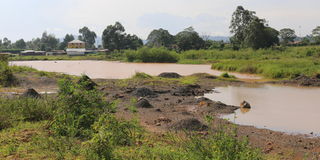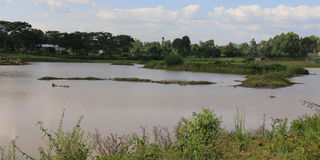
Concrete platforms still standing at Iribo Swamp, Nandi County, an area that was once used as a ballast crushing site during the construction of Kisumu-Kakamega Highway.
| Pauline Ongaji | Nation Media GroupNandi
Premium
This Nandi village got a new road… and many problems
From afar, you might think it’s a lake. Waterholes, swamps and marshes dot the landscape.
In the sweltering heat, about a dozen young men armed with shovels and plastic buckets are busy digging around the waterholes.
At a closer look, the piles of ballast around the puddles signal what lies beneath. They are here for the ballast.
At the farthest point lies the biggest and deepest waterhole – deep enough for an elephant to drown in.
A few meters away, there is a huge concrete platform that towers above the water level of one of the ponds.
This is where the ballast stone-crushing machinery had been erected. Next to it is a broken transformer that used to transmit power to the machinery.

What is left of the power supply system after the ballast crushing activity at Iribo, Nandi County.
This is the remaining picture of a piece of land in Iribo village of Nandi County that was once used as a gravel crushing site by China Overseas Engineering Group Co. Ltd (COVEC) Kenya.
It had been contracted to construct the Kisumu-Kakamega Highway between 2013 and 2019.
Environmental degradation
But all good things come with a few disadvantages.
The negative outcome of the road construction is that it resulted in environmental degradation.
Now Iribo villagers are up in arms over the deterioration of their environment: The price they had to pay for a new road.
“There has been an alteration of the natural landscape, as well as stagnant water, now a breeding ground for parasites and diseases. The locals are also facing the danger of drowning from these waterholes,” says Kigame Kisia, a local environmental activist.

Ponds at the Iribo Swamp in Iribo, Nandi County.
Mzee Nerbert Ashiolo, 68, whose two-acre piece of land borders this area, isn’t happy either.
“I now live in fear, worried that my grandchildren could drown in these deep waterholes. This has now become a flood-prone area. We have lost crops and trees due to the floods, something that we hadn’t experienced before,” he says.

Mzee Nerbert Ashiolo, during the interview at his home in Iribo. His farm borders the Iribo Swamp where COVEC had erected a ballast crushing machinery.
“It reminds us of the company’s operations. Other than the noise from the heavy machinery, we had to endure dust pollution.”
Another resident, Phillip Marigi, says floods have rendered one of the pathways into the village impassable.
“The floods began in 2019 after the company left. Our lives have been turned upside down. It’s just misery as we live in fear of being swept away whenever it rains,” he says.
Environmental regulations
As the voices of discontent continue rising from the angry residents and environmental activists, some believe COVEC Kenya did not breach any environmental regulations.
James Meli, deputy director of environment and natural resources at the county government, says the site was only used to assemble equipment.
“I don’t think the company’s operations caused any environmental damage. About the deep hole, we don’t know how deep it is. We had told the company to fence the place but it was destroyed by hooligans,” he says.
Ali Mwanzei, deputy director, field operations at the National Environment Management Authority (Nema), agrees.
“A ballast crusher was mounted at the site. The raw materials came from Vihiga County, so there was no excavation on site. This means the question of alteration of contours of the land is unfounded,” says Mwanzei, adding that the perusal of records shows that the office never received or recorded complaints of dust pollution, or any other, during the project.

A pond at the Iribo Swamp in Iribo, Nandi County.
“During the decommissioning process, the company had obtained an environmental impact assessment license for the operation, and one of the conditions was to undertake decommissioning to the satisfaction of the authority. They applied to move out, and Nema visited the site with a team from the county government, local people and site handed over to the Nandi administration,” says Mwanzei.
Errant locals
He blames the mess on errant locals.
“First, safety starts with you. I am informed the company fenced the area to limit access to the site, but it was vandalised. What was left were gravel and a gatehouse, which was handed over to the community for their use for a proposed ecotourism site. The contractor was asked to construct a sign saying ‘you are now crossing the equator’ for ecotourism and fenced off the site. Sadly, it was destroyed. The county government has planned to start an ecotourism project site for the community there,” he offers.
Vincent Mahiva, the county director of environment, defends the Chinese and insists there is no cause for alarm.
“We followed everything as needed and found that the place was totally safe, apart from the water. They fenced the place and handed over to the county government. We (with Nema) were all satisfied,” he says.





